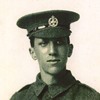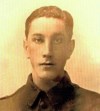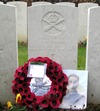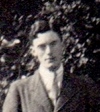Henry Williamson and the London Rifle Brigade, 1914–1915: an illustrated timetime
Henry Williamson and 208 Machine Gun Company
Henry Williamson at Trefusis House, 1917
Henry Williamson at Felixstowe with the 3rd Battalion, The Bedfordshire Regiment, 1917–18
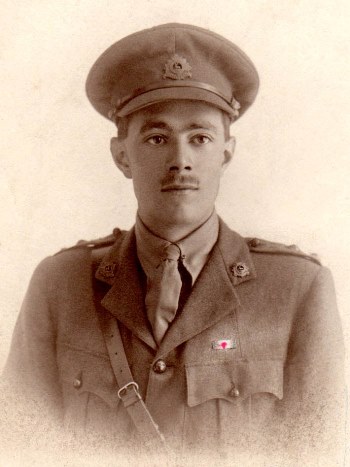
|
Lieutenant Henry W. Williamson in 1917 3rd Battalion The Bedfordshire Regiment |
Henry Williamson served throughout the First World War, an experience from which he never recovered. On various levels he was in a state of breakdown for the rest of his life. The war became the fulcrum of his life’s see-saw. It dominated everything. After the war's end he wrote after the last entry in the ‘Boy’s Nature Diary’ that he had kept until 1914:
HW was a soldier 2¼ months later; in France 5¼ months later
And Finish, Finish, Finish, the hope and illusion of youth,
For ever, and for ever, and for ever.
Thereafter, Henry Williamson could never enjoy Christmas – rather, Christmas was a torment for him because every year he relived the 1914 Christmas Truce, when he spoke to German soldiers and discovered that their hopes and fears were the same as those of himself and his English comrades, and that German soldiers dying in agony cried out for their mothers just as did the English Tommy. The slightest sight or sound would catapult him back into the battlefields. His formidable Aunt Maude had told him – in a war that tended to be called ‘The Cousin’s War’ (due to the Royal Family’s close German connections) – that he was literally fighting his own cousins, for he had a German grandmother. A troubling thought for a sensitive and immature lad; he had just turned nineteen at the time of the Truce. He came to realise that all men are brothers, and that war was futile and evil: basically engineered by political machination. His life’s credo was that it must never happen again, and to pursue that end through the medium of writing: to write the truth – the cause and effect.
This page serves as an introduction to both Henry Williamson's personal experiences and his writing about the war. It will include links to other relevant pages within this website, and to articles on the First World War that have appeared in the Society's journal. See also Biography: First World War.
Those interested in finding out more about HW's war should read Anne Williamson's definitive Henry Williamson and the First World War (Sutton Publishing, 1998; paperback 2004), regrettably now out of print, but which is highly recommended.
*************************
In 1928, ten years after the opening of the Battle of Arras, on 8 August 1918 – the battle that broke the stalemate of the trenches, Henry Williamson was asked by the Daily Express to write a series of articles on The Last 100 Days – there were nine published in all, but also three unpublished – about 'the principal events of the last hundred days of the war'. They make remarkable reading, and are given an effective immediacy, for Williamson, unusually, wrote them as reportage.
Henry Williamson first wrote of his own war experiences in The Wet Flanders Plain, published in the following year, 1929, being his reminiscences after a return to the battlefields. This was followed by The Patriot's Progress in 1930, which is the story of John Bullock, an ‘everyman’ soldier, and considered a classic in the genre of war novels. But mainly he used his war experiences in his later long series of novels – How Dear Is Life, A Fox Under My Cloak, The Golden Virgin, Love and the Loveless, and A Test to Destruction. (Vols 4, 5, 6, 7, and 8 of A Chronicle of Ancient Sunlight) – which record the horror, terror and thrill of that terrible experience.
One of Williamson's most moving and significant essays is his powerful 'I Believe in the Men Who Died', which first appeared in the Daily Express on 17 September 1928, and then published in The Wet Flanders Plain, re-titled 'Apologia pro vita mea'. Here he sets out what he feels is the reason for his surviving the war: to be a voice for those who had died. Anne Williamson has stated in her survey of The Wet Flanders Plain that '"Apologia" is, to my own mind, one of the most – possibly the most – important piece of writing in HW’s whole oeuvre – in his whole "life’s work": certainly it must be read by anyone who wants to understand what underpins HW’s psyche.'
Four years later, in July 1932, the BBC invited Henry Williamson to 'give an address, on some date near Armistice Day, to the Unknown Warrior'. He submitted the script for his talk on 15 September; but the BBC rejected it: 'It was not really what we had hoped for.' Neither did they want him to re-work it, and in the event there was no broadcast on the subject. Williamson included an amended version of the script in his book Goodbye West Country (Putnam, 1937), which purports to be a diary of the year 1936, as the entry for 11 November. It is entitled 'To the Unknown Soldier'; the web page also includes a copy of his much amended hand-written draft of the script refused by the BBC.
In 1964, to mark the fiftieth anniversary of the beginning of the First World War, the Evening Standard asked Henry Williamson to revisit and write about the battlefields of the Western Front. His five reports were published between 29 June and 3 July under the heading 'Return to Hell'. They were subsequently reprinted as a additional postscript in Gliddon Books' new edition of The Wet Flanders Plain (1987), which has long been out of print, and we are now pleased to reproduce them here.
HW was interviewed in 1963 for the major 26-part series The Great War, made under the auspices of The Imperial War Museum for BBC television and broadcast in 1964 to mark the fiftieth anniversary of the outbreak of the war. This groundbreaking series was later issued as a videocassette boxed set, and subsequently on DVD. In March 2014 the BBC made available on iPlayer The Great War Interviews: thirteen full-length interviews that were originally recorded for the series; only brief excerpts were used at the time, and the complete interviews have never before been broadcast. Interviewees included Norman Macmillan (infantryman turned fighter pilot, and author of Into the Blue and Offensive Patrol); Charles Carrington (who, writing as Charles Edmonds, published A Subaltern’s War); and Cecil Lewis (author of the classic memoir of the air war, Sagittarius Rising). Click on the link for HW's interview, which lasts almost half-an-hour.
*************************
John Gregory's 'The Great War in the Writings of Henry Williamson' is an exploration of the subject in both published and unpublished writings.
TIMELINE – Henry Williamson's diary of service
(Links to relevant web pages and journal articles for further reading are highlighted. The link will open in a new window.)
|
|
||
| 22 January | Joins the London Rifle Brigade (LRB), 5th Battalion City of London Regiment, as a Territorial soldier, enrolment No. 9689. Expected to attend three drills per month, involving activities such as rifle training, gymnastics and boxing to keep fit, and attending the summer camp. | |
|
16 May– 1 June |
Takes annual holiday, staying with his Aunt Mary Leopoldina Williamson in Georgeham, North Devon, a visit significant for his future life.
Journal article: Henry Williamson: 'The Last Summer' (HWSJ 11, April 1985) |
|
| August | The LRB's scheduled summer camp is cancelled. | |
| 5 August |
Troops mobilise. HW is a private in P Company, LRB, aged 18 years and 8 months. Training commences: at first in London at the Merchant Taylor's School, then at Charterhouse. By 24 August the LRB is camped at Bisley (familar to HW from schools rifle competitions).
Private Jack Widdicombe is in E Company. He is badly injured on the first day of the Battle of the Somme, with bullet wounds to his right thigh, left forearm, and another through his jaw, ending his war. He subsequently spent 190 days in hospital. His letters home are being published as a blog, Jack's War (external link), 100 years to the day from when he wrote them.
The three Daniel brothers, Herbert, Alfred and Harold, enrol in the LRB on 6 August, in G and H Companies. Alfred is shot by a sniper in January 1915 and dies the next day; Harold is found to be under age and sent back to England early in 1915. Herbert (MC and Bar) survives the war and makes a career in the regular Army.
Web page: Henry Williamson and the London Rifle Brigade, 1914–1915: an illustrated timeline |
|
| 16 September | The LRB marches to the main training camp in Ashdown Forest near Crowborough, Camp Hill Camp, where more serious training commences, with trench digging etc. | |
| 4 November | Orders are received to entrain to Southampton, where the LRB embark on the troopship Chyebassa for Le Havre in France. The Brigade is moved gradually up to the front. | |
| 19 November | Established in the village of Romarin, just outside Ploegsteert ('Plugstreet') Wood. The LRB is detailed as 'support troops' on rotational duties of three days in trenches, three days in support immediately behind the lines, and three days' rest in billets to wash, shave and pick lice out of uniforms (but still on fatigue duties). | |
| 19 December | The LRB is in support for an attack by 11th Infantry Brigade in front of Plugstreet Wood. The attack is aborted and the LRB not called upon to continue it. | |
|
24 December (Christmas Eve) |
HW is detailed as part of a wiring party in No Man's Land after dark: a dangerous task, with the need to be silent, and very vulnerable to snipers and other gunfire as out in the open.
He sees a light over the German trenches, and hears the singing of 'Stille Nacht, Heilige Nacht' (the British carol 'Silent Night, Holy Night'). German soldiers call out 'Come over, Tommy! Shake hands. It is Christmas.' Eventually nervous men climb out of trenches and both sides mingle. |
|
| 25 December |
Fraternisation continues: soldiers exchange gifts – tobacco and cigarettes sent by Princess Mary to British troops for cigarettes and tobacco sent by the Crown Prince to German troops. Some men kick a football around together. HW no doubt witnesses this, as it happens in his section of the line, but does not record it at the time, only talking about it later.
The fraternisation continues for two or three days more, then men are ordered to resume fighting. This is never allowed to happen again, and the following year British troops are told that they would be shot if any fraternisation occurs.
Web page: Henry Williamson and the Christmas Truce Web page: Henry Williamson: 'The Christmas Truce' (History of the First World War, vol. 2, no.4, 1970) Web page: Henry Williamson: 'Silent Night – when the guns held their peace' (Daily Express, 19 December 1970) Web page: Richard Williamson: 'Black earth and the silence of peace in No Man's Land' (Chichester Observer, 26 December 2013) |
|
| 26 December |
HW writes a letter home describing these events. His fathers sends the letter to the Daily Express, which prints an extract, together with extracts from the letters of other soldiers, in an article headed 'The Unofficial Truce', on 4 January 1915.
The effect of the Christmas Truce marks HW for life. |
|
| 1915 |
|
|
| 19 January | HW is hospitalised with severe trench feet and dysentery. | |
| 26 January | He returns to England and sent to Ancoats Hospital, Manchester, and later to Alderley Edge Convalescent Hospital. | |
| Early March | Returns home (his older sister describes him as 'a terrible sight . . . we could hardly recognise him . . . very pale and thin . . .'). He is given three weeks' leave. Applies for a commission. | |
| 10 April |
Commission is gazetted: Temporary 2nd Lieutenant, 10th Service Battalion, The Bedfordshire Regiment.
Commences officer training |
|
| May | Buys Norton motorcycle LP 1656. Attends initial Officers' Instruction Course at Sevenoaks, Kent. At the end of the course HW is instructed to report to Newmarket, where he is attached to the 2/1st Cambridgeshire Regiment for further training. It is a difficult time for him as he is something of a misfit. | |
| 9 October | He is transferred to 25th (Reserve) Battalion, Middlesex Regiment – 'The Diehards' – at Hornchurch, raised by the colourful Independent MP John Ward, an agitator for better conditions and pay for navvies, and now lieutenant colonel of his battalion. | |
| End of 1915 | Reorganisation, and a new battalion is formed; HW and other officers are transferred to Northampton, and sent on a Lewis Gun Course. On his return he is given four days' leave for Christmas. | |
| 1916 |
|
|
| January |
Transferred to the Machine Gun Training Centre at Grantham, and joins 208 Company, The Machine Gun Corps, 62nd Division, 187 Brigade.
HW spends the greater part of 1916 training as a Transport Officer, learning about the maintenance and firing of Vickers machine guns, and how to look after both horses and mules.
|
|
| 31 May | Admitted to Millbank Military Hospital. | |
| 26 June |
The report of the Medical Board states that 'he is now better but lost weight and is anaemic. He requires a complete change.' HW is given two month's leave, part of which he spends in Georgeham, North Devon, with his friend Terence Tetley.
This period of sickness greatly holds up his training, but it is completed by the end of 1916. |
|
|
1 July– 13 November |
The Battle of the Somme
Web page: Henry Williamson: 'When the sun arose that day on Picardy 60,000 were never to see it set' (Western Morning News, 7 August 1959) Web page: Henry Williamson: 'The Somme – just fifty years after' (Daily Express, 29/30 June, 1 July 1966) Web page: Henry Williamson: '7.30 a.m.: a time of hope that became an execution hour' (Evening Standard, 4 July 1966) Web page: Henry Williamson: [untitled, on the Battle of the Somme]; one of a number of articles commissioned to mark fifty years since the ending of the First World War (Daily Express, 9 November 1968) |
|
| 15 September |
Henry's schoolfriend, Rupert Bryers, a lance-corporal in the 9th Battalion, The Rifle Brigade, is wounded, missing and presumed killed near Guendecourt on the Somme, aged 20. His body is later recovered and he is buried in Guards Cemetery, Lesboeufs.
Web page: Anne Williamson: 'Rupert Bryers: An homage at his grave, Les Boeufs Cemetery, 20 April 2013' |
|
| 16 November |
Henry's cousin, Charlie Boon, is killed on the Somme. He is buried in Frankfurt Trench Cemetery.
Journal article: Anne Williamson (compiler): 'Cousin Charlie: a tribute' (HWSJ 43, September 2007) |
|
| 1917 |
|
|
| 6 January | HW diary entry: 'Go to 208 as T.O.' | |
| 24 February | 208 MGC leave Grantham for Southampton. They embark with all animals on the next evening, and arrive at Le Havre at 2 a.m., 26 February. | |
| 28 February |
208 MGC, attached to 187th Infantry Brigade, 62nd Division, moves up to the front line at Astreux. HW's role as Transport Officer is to oversee the welfare of horses and mules, and to organise the logistics of movements of guns and armaments, together with general support, such as arranging billets and provisions for both horses and men.
So begins a period of continuous movement from village to village, backwards and forwards, with attacks and counterattacks (see Anne Williamson's Henry Williamson and the First World War for full details) in preparation for the attack on the Hindenburg Line, commencing on 3 May.
Web page: Henry Williamson and 208 Machine Gun Company Web page: 208 Machine Gun Company: HW's photographs Journal article: Peter Cole: 'The 286th Machine Gun Company' (HWSJ 18, September 1988) |
|
| 9–12 April |
The Canadian Corps takes Vimy Ridge.
Web page: Henry Williamson: 'The Battle of Vimy Ridge' (Daily Express, 6/7 April 1967) |
|
| 8 June |
HW is gassed on a night journey taking limbers with supplies of ammunition up to the front line. One of the mule drivers, Private Frith, is killed by a shell within yards of him. He is admitted to a Field Ambulance Hospital.
Web page: Driver Frith |
|
| 10 June | Taken to 44 Casualty Clearing Station at Colincamps, and thence to Warloi Clearing Hospital. | |
| 15 June | Moves to No. 8 General Hospital at Rouen. Diary entry, 15 June: 'For England by first boat!' | |
| 18 June | Arrives back in Southampton, and leaves for London and Sussex Lodge Hospital. | |
| 22 June | Medical Board – HW is considered unfit for General Serice for three months, unfit for Home Service for two months, and unfit for Light Duties for one month. | |
| 29 June |
HW travels down to the Auxiliary Hospital for Officers at Trefusis House, near Falmouth, Cornwall. Among the friends he makes here is Major Colin Traill, MC.
Web page: Henry Williamson at Trefusis House Journal article: Anne Williamson (compiler): '"My Friend": Major Colin B. Traill, MC' (HWSJ 43, September 2007) |
|
| 3 July | HW diary entry: 'Began story.' There are no other details, but it seems probable (with hindsight), that writing has been recommended to him as a form of therapy for his extreme state of nervous exhaustion – then known as shell shock; in the Second World War as battle fatigue; and later as post-traumatic stress syndrome. | |
| 29 August | Moves from Trefusis to Devonport Military Hospital. | |
| 24 September | A Medical Board notes that he has improved and fit for light duty, but still 50 per cent unfit; he is given three weeks' leave. | |
| 15 October |
HW is posted to C Company, 3rd Battalion, the Bedfordshire Regiment, stationed at Landguard Camp just outside Felixstowe, Suffolk, as (assistant?) adjutant. The CO is Lieutenant Colonel Lord Ampthill.
Regular medical boards still mark him for general home duties only and unfit for front-line service.
Web page: Henry Williamson at Felixstowe |
|
| 30 November |
HW notes in his diary, 'Bosche counter attack. Transport lost.' This refers to the Battle of Cambrai. On this day Brigadier General Roland Boys Bradford, VC, MC, commanding 186th Infantry Brigade during the battle, is killed when a shell hits his headquarters. Aged just 25, and known as 'the Boy General', he is the youngest Brigadier General in the Army. He is one of the four remarkable Bradford brothers (external link) who between them win two VCs and two MCs during the First World War. He appears as a character in Love and the Loveless. |
|
| 1918 |
|
|
| 27 February | The latest Medical Board rules that HW is still 'debilitated and under 20 per cent fit', and unfit for active service. But he is getting very frustrated and wants to get back to the Front. | |
| 1 March | Diary entry: 'Switched name from H.S. [Home Service] to Overseas.' (As adjutant, it is possible to see that he is able to do this.) The incident appears in HW's novel A Test to Destruction. | |
| 22–26 March |
He is given four days' leave prior to embarking for France. It appears that he is detailed to escort a draft of soldiers to the Front. To do this, technically he has broken regulations, but it may have been with some tacit permission, as every man is needed at this time. There is no corroboration whatsoever of this event; records are in total chaos as the Germans make their last massive effort to attack and break through the lines, and so win the war: the German Spring Offensive.
Journal article: Paul Reed: 'Henry Williamson and the Kaiserschlacht, March 1918' (HWSJ 18, September 1988) Journal article: Dr Mike Maloney: 'A Test of Detection: the missing days, April 1918' HWSJ 43, September 2007) - Section 1; and Section 2 (This article is presented here in two sections because of the large file size.) |
|
| 18 April |
HW diary entry: 'Left Hall-Walkers Hospital in Regent's Park.' He is then given a few days' leave, and then attends a routine Medical Board on 26 April. He is still assessed as 20 per cent disabled.
Continues his duties at Landguard Camp. |
|
| 28 June | HW's friend from Trefusis House, Major Colin Traill, MC, is killed, aged 23. He is buried at Le Grand Hasard Cemetery, Morbecque.
Journal article: Anne Williamson (compiler): '"My Friend": Major Colin B. Traill, MC' (HWSJ 43, September 2007) |
|
| 4 September | HW seems to have applied to join the RAF: diary entry reads: 'Failed Air Force. Not fit. Hell.' | |
| 28 September | HW diary entry: 'Am going to India! My transfer to Indian Army came through! B1 category no bar!!' | |
| 2 October | Given leave prior to leaving for India. | |
| 28 October | A telegram recalls HW to Landguard Camp, where he learns that he is to embark on 4 November. | |
| 3 November | HW is told that orders are cancelled, and he returns home. | |
| 7 November | HW diary entry: 'War ending.' He is recalled Landguard Camp the next day. | |
| 11 November |
HW diary entry: 'Armistice signed at 5.30 this morning. Bands playing, guns, sirens, etc. etc. PEACE!'
Journal article: Henry Williamson: 'Ten Years' Remembrance – 11th November 1928' (HWSJ 18, September 1988) |
|
| 20 November | Witnesses around 20 German U-boats enter Harwich harbour in surrender: 'Saw scores, painted dragons on bows, saw-edge to cables over conning towers etc. Crews all to attention entering Orwell estuary.' The men had orders to be silent and at attention. | |
| 9–26 December | HW is on leave. | |
| 27 December | At the end of his leave HW is posted to No. 1 Dispersal Unit at Shorncliffe, and at some later point to No. 3 Rest Camp, Folkestone. His duties as adjutant are in dealing with soldiers returning from the Front. | |
| 1919 |
|
|
| September |
Posted to Brockton Camp at Cannock Chase in Staffordshire – where he more or less opts out of army life, neither dining nor attending parades, but spending his time reading and writing in 'my asbestos cubicle'. His CO realises that he is suffering from war stress and decides to release him from service forthwith. |
|
| 19 September |
HW is demobilised.
Web page: Henry Williamson: 'When I Was Demobilised' (Strand Magazine, September, 1945) |

